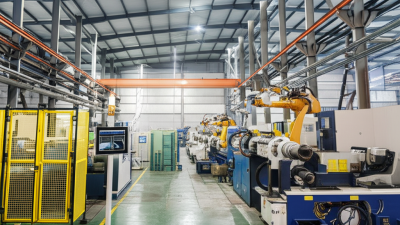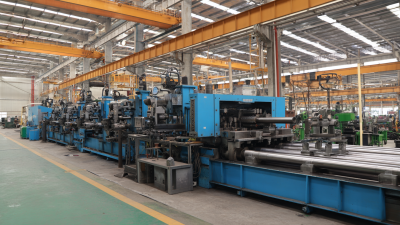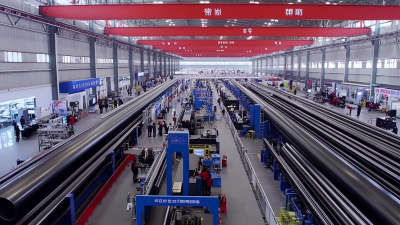
 In the dynamic world of manufacturing, selecting the right Tube Mill Making Machine is crucial for ensuring efficiency and quality in production. With advancements in technology and varying industry demands, manufacturers face the challenge of choosing a machine that not only meets their specific needs but also aligns with future growth prospects. Industry expert John Smith, a leading figure in manufacturing technology, emphasizes, "The right Tube Mill Making Machine can significantly enhance productivity and reduce costs, making it an essential investment for any manufacturing operation."
In the dynamic world of manufacturing, selecting the right Tube Mill Making Machine is crucial for ensuring efficiency and quality in production. With advancements in technology and varying industry demands, manufacturers face the challenge of choosing a machine that not only meets their specific needs but also aligns with future growth prospects. Industry expert John Smith, a leading figure in manufacturing technology, emphasizes, "The right Tube Mill Making Machine can significantly enhance productivity and reduce costs, making it an essential investment for any manufacturing operation."
As we dive into the intricacies of tube mill machinery, it becomes evident that understanding the features, capabilities, and potential applications of these machines is fundamental. Manufacturers must consider not only the immediate requirements of their operations but also how a specific tube mill machine can adapt to changing market dynamics. With the upcoming release of the "2025 Top 10" list, highlighting the best tube mill machines available, it is imperative for businesses to evaluate their options carefully and select a model that fulfills their manufacturing aspirations. By making informed decisions, companies can position themselves for enhanced productivity and competitiveness in an evolving landscape.
When selecting the right tube mill making machine, it is crucial to thoroughly understand your specific manufacturing requirements. Begin by assessing the type of tubes you intend to produce, including their materials, sizes, and wall thicknesses. Different applications, such as construction, automotive, or industrial piping, may demand varying specifications. Identifying the desired production rate and quality standards will also influence the features necessary in the tube mill.
Another vital aspect to consider is the flexibility and scalability of the machine. As market demands can fluctuate, having a machine that allows easy adjustments or expansions will provide long-term benefits. It's important to evaluate the machine's compatibility with your existing manufacturing processes and equipment to ensure a smooth integration. Moreover, consider the support and maintenance services offered by the manufacturer, as these can significantly impact the longevity and efficiency of your production line. By systematically addressing these factors, you can make a more informed decision when choosing the right tube mill making machine for your needs.
When selecting a tube mill making machine, several key features are essential to ensure it meets your manufacturing needs effectively. Firstly, consider the machine's production capacity. Understanding the desired output will help you choose a model that can handle your anticipated volume without compromising on quality. Additionally, evaluating the thickness and diameter range the machine can accommodate is crucial, as this will determine the versatility of your production line.
Another vital aspect to examine is the automation level of the tube mill. Modern machines with automated features can significantly enhance efficiency and reduce labor costs. Look for machines equipped with advanced controls and monitoring systems that allow for precise adjustments and real-time data tracking. Finally, do not overlook the importance of after-sales support and maintenance services offered by the manufacturer, as these can greatly influence the long-term performance and reliability of the equipment. By considering these features, you can select a tube mill machine tailored to your specific requirements and operational goals.
When selecting a tube mill making machine, it is crucial to evaluate the various technologies available in the market to ensure that you make an informed decision. Different tube mill technologies, such as high-frequency welding, submerged arc welding, and spiral welding, offer distinct advantages and are suited for specific production requirements. High-frequency welding, for instance, is known for its speed and efficiency, making it ideal for large-scale manufacturing, while submerged arc welding provides exceptional quality for thicker materials.

Moreover, the automation level of the tube mill can greatly influence productivity. Advanced technologies come with features such as automated feeder systems and programmable controls, leading to enhanced precision and reduced operational costs. This is particularly beneficial for manufacturers looking to improve their throughput without compromising quality. Understanding the capabilities and limitations of each technology is vital for aligning the machine’s performance with the specific needs of your production line. Therefore, a comprehensive evaluation of these factors plays a significant role in choosing the right tube mill making machine.
When selecting a tube mill making machine, budgeting is a critical factor that goes beyond initial costs. Investing in a high-quality machine often entails a higher upfront price; however, this can lead to significant long-term value. A robust tube mill is typically more durable, requires less maintenance, and can produce higher-quality products, ensuring that your manufacturing operation runs smoothly over time. Businesses that choose to invest wisely in their machinery may experience lower operational costs and enhanced productivity, providing a better return on investment.
Moreover, it is essential to consider the total cost of ownership, which includes maintenance, energy consumption, and potential downtime. A cheaper machine may seem appealing initially but could incur substantial expenses if it breaks down often or requires frequent repairs. Evaluating the long-term performance and reliability of tube mills can give manufacturers a clearer picture of their true costs. Thus, balancing the upfront investment with the machine's lifespan and ongoing costs is vital for making a sustainable decision that aligns with manufacturing goals.
| Feature | Option A | Option B | Option C |
|---|---|---|---|
| Initial Investment | $50,000 | $75,000 | $100,000 |
| Operating Costs (Annual) | $10,000 | $12,500 | $15,000 |
| Production Speed (Meters/Minute) | 30 | 40 | 50 |
| Lifetime (Years) | 10 | 12 | 15 |
| Maintenance Difficulty | Moderate | Easy | Difficult |
| Output Quality (Range) | Good | Very Good | Excellent |
When choosing a tube mill making machine, the reliability of the supplier and the level of after-sales support can significantly impact your manufacturing operations. According to a report by MarketsandMarkets, the global tube and pipe market is projected to reach $140 billion by 2025, emphasizing the importance of having robust machinery that meets production demands efficiently. Suppliers that provide reliable machines often have a proven track record of quality, which can be assessed through customer testimonials and industry certifications.

Furthermore, after-sales support, including training, maintenance, and quick access to spare parts, is crucial for minimizing downtime. A study by Technavio highlights that companies with strong after-sales service see a 15% reduction in machine-related downtime, which can lead to substantial savings. It's essential to evaluate potential suppliers not only on the specifications and features of their tube mills but also on their commitment to ongoing support. This ensures that your investment is safeguarded and that your manufacturing capabilities can scale up seamlessly as demand shifts.






